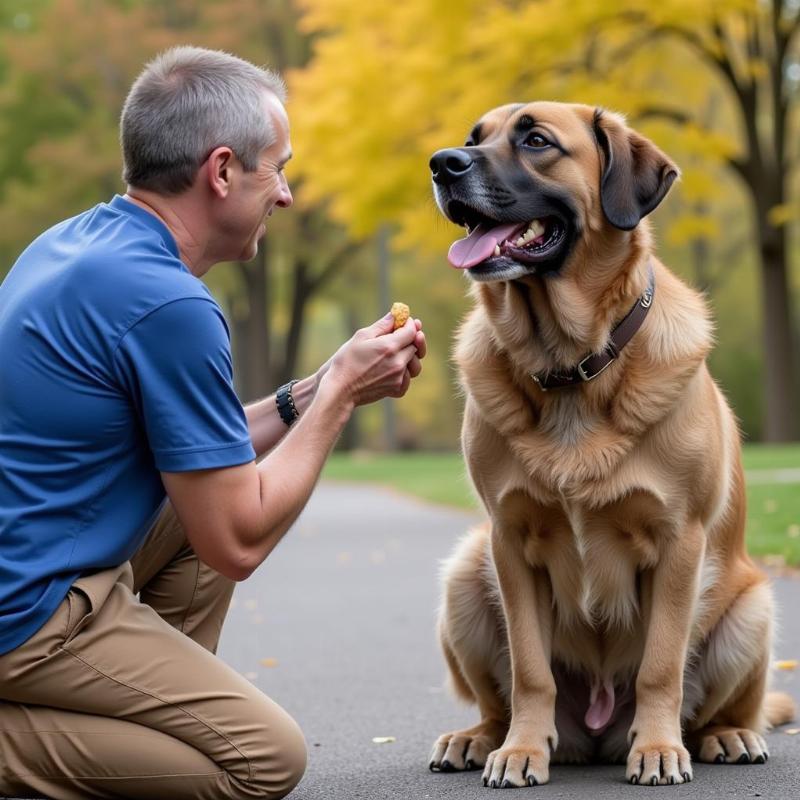Shock collars, also known as e-collars or training collars, are a controversial tool often considered for extra large dog breeds. Understanding their proper use, potential risks, and humane alternatives is crucial for responsible pet ownership. This guide will provide you with the information you need to make informed decisions regarding the use of shock collars for your extra large companion.
Understanding the Needs of Extra Large Dogs
Extra large breeds, such as Great Danes, Mastiffs, and Saint Bernards, present unique training challenges due to their size and strength. These gentle giants require consistent and positive reinforcement methods. While some owners may consider shock collars for behavioral modification, it’s vital to prioritize their well-being and explore other training avenues first.
Are Shock Collars Humane for Extra Large Dogs?
The humaneness of shock collars is a hotly debated topic. While proponents argue they can be effective for curbing unwanted behaviors, opponents emphasize the potential for physical and psychological harm. The intensity of the shock, the dog’s temperament, and the trainer’s experience all play a role in determining the overall impact. Misuse can lead to fear, anxiety, and aggression, potentially worsening the very behaviors the collar was intended to address. harnesses for extra large dogs are often a preferred alternative.
Exploring Alternatives to Shock Collars
Fortunately, numerous humane and effective training methods exist for extra large dogs. Positive reinforcement, using treats and praise, builds a strong bond between owner and dog while encouraging desired behaviors. best shock collar for little dogs may have a different approach, but for large breeds, positive reinforcement is key. Harness training, clicker training, and professional guidance from a certified dog trainer are all valuable resources for addressing behavioral issues without resorting to aversive methods.
 Positive Reinforcement Training for an Extra Large Dog
Positive Reinforcement Training for an Extra Large Dog
Choosing the Right Training Tools and Techniques
If, after careful consideration and consultation with a veterinarian or certified professional dog trainer, you decide to use a shock collar, it’s crucial to choose the right one. Look for collars with adjustable intensity levels and safety features to prevent accidental shocks. Prioritize training methods that focus on positive reinforcement and use the shock collar as a last resort. Remember, the goal is to guide your dog towards desired behaviors, not to inflict pain or fear. shock collars for big dogs come in various types, and selecting the right one is essential.
Shock Collar Safety and Precautions for Extra Large Breeds
Safety should be paramount when using a shock collar. Always start with the lowest intensity setting and gradually increase only if necessary. Avoid prolonged use, and never leave the collar on unsupervised. Regularly check the collar for any signs of damage or malfunction. Consulting with a veterinarian is essential to ensure the collar is appropriate for your dog’s size, breed, and health condition. For some breeds, most powerful dog shock collar may not be the appropriate choice.
Conclusion
Training extra large dogs requires patience, consistency, and a commitment to humane methods. While shock collars may be an option in certain situations, it’s crucial to exhaust all positive reinforcement techniques and consult with professionals before resorting to aversive tools. Prioritize your dog’s well-being and focus on building a strong, trusting relationship through positive interactions and effective communication. Remember, a well-trained extra large dog is a happy and well-adjusted member of the family.
FAQ
- Are shock collars legal in the US? Yes, shock collars are generally legal in the US, but regulations vary by state and locality.
- Can shock collars cause aggression in dogs? Improper use of shock collars can lead to increased fear and anxiety, potentially manifesting as aggression.
- What are some alternatives to shock collars for large dogs? Positive reinforcement training, harness training, and professional guidance are all humane alternatives.
- How do I choose the right size shock collar for my extra large dog? Consult with a veterinarian or professional dog trainer for guidance on selecting the appropriate size and type.
- Are there any health risks associated with shock collars? Misuse can cause physical injuries, such as burns or neck pain, and psychological distress.
- Can I use a shock collar on a puppy? Shock collars are generally not recommended for puppies. Consult with a veterinarian.
- How do I introduce a shock collar to my extra large dog? Consult a professional dog trainer for guidance on proper introduction and usage.
Related Articles:
Beautdogs.us is your premier online resource for all things dog-related in the US. We offer expert advice on dog breeds, care, training, and product reviews. Whether you’re a first-time dog owner or a seasoned pro, Beautdogs.us is your trusted source for comprehensive and engaging information. Contact us today for personalized support: Email: [email protected], Phone: +1 501-555-7529.